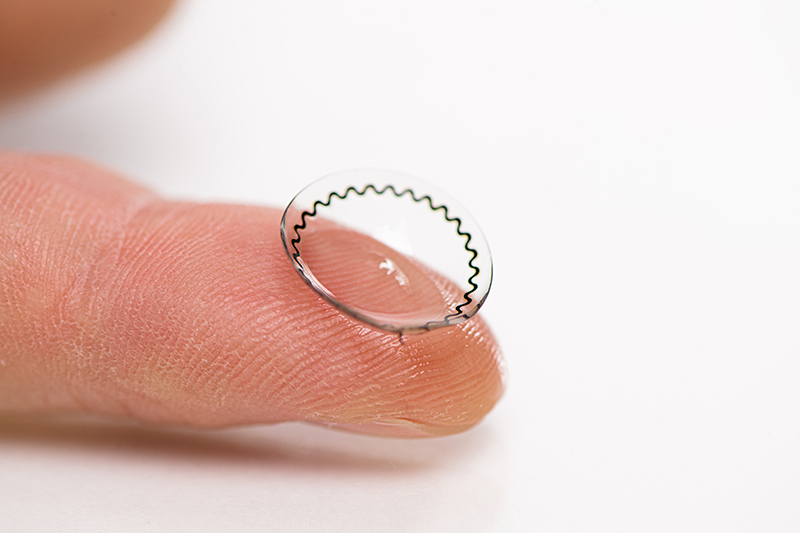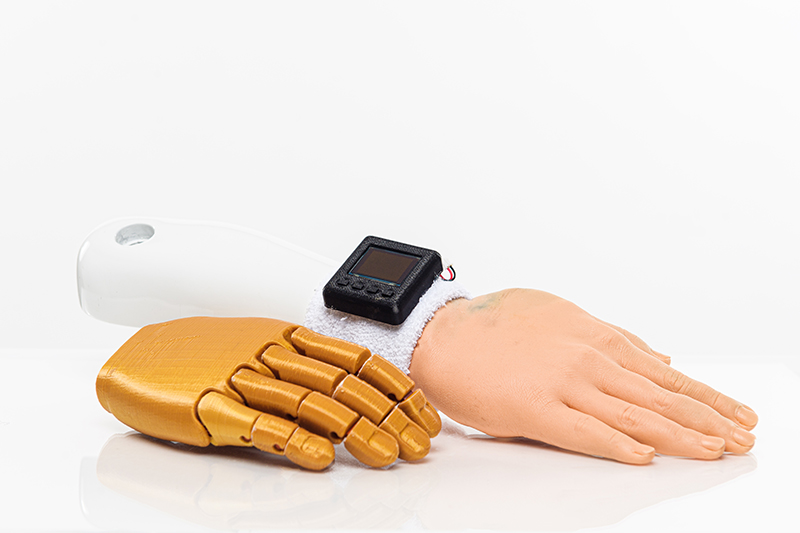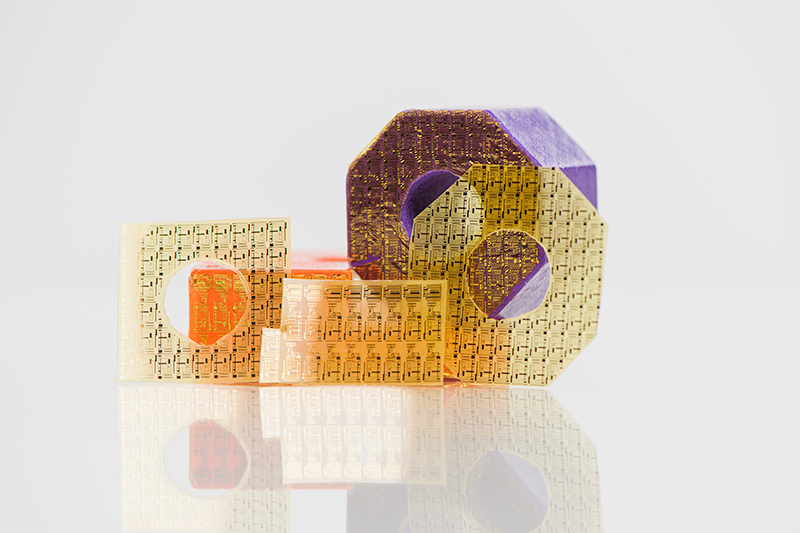September 8, 2021
Enhancing ordinary items for addressing health outcomes

Biomedical engineer Chi Hwan Lee developed a sensor that can be placed on an over-the-counter contact lens and then used to detect glaucoma in patients. (Purdue University photo/Rebecca McElhoe)
Biomedical engineering professor turns objects into smart devices to improve, address health issues
WEST LAFAYETTE, Ind. — As a child, Chi Hwan Lee always had Lego sets on his birthday list. Lee, who loves math and physics, would spend hours building the sets – following the instructions as well as his imagination.
That imagination and those Lego pieces became the building blocks of Lee’s Purdue University research, which focuses on converting items like contact lenses and prosthetic hands into smart devices with specially designed electronic stickers to measure vision loss or simulate the sense of feeling.
 Chi Hwan Lee and his students have developed an electronic glove that simulates the sense of touch for prosthetic hands. (Purdue University photo/Rebecca McElhoe)
Download image
Chi Hwan Lee and his students have developed an electronic glove that simulates the sense of touch for prosthetic hands. (Purdue University photo/Rebecca McElhoe)
Download image
From solar cells to biomedical applications
Lee, the Leslie A. Geddes associate professor of biomedical engineering in Purdue’s Weldon School of Biomedical Engineering, says his passion for creating and assembling items continues to grow, thanks to the entrepreneurial and collaborative environment at Purdue.
While his initial research involved developing additive manufacturing processes to convert solar cells and sensors to become flexible and even wearable, it was during his job interview at Purdue where faculty members asked if he had ever thought about using his solar cell work in a biomedical setting.
That moment was pivotal for Lee, who now has a joint appointment in the School of Mechanical Engineering and a courtesy appointment in the School of Materials Engineering.
“All of those discussions were very productive. The Purdue faculty looked at the technology that I was working on and encouraged me to explore applications that I never dreamed about,” Lee says. “Purdue has a perfect environment for me to do these interdisciplinary collaborations.”
 Purdue biomedical engineer Chi Hwan Lee specializes in sticktronics and custom-printed soft medical sensors. (Purdue University photo/Rebecca McElhoe)
Download image
Purdue biomedical engineer Chi Hwan Lee specializes in sticktronics and custom-printed soft medical sensors. (Purdue University photo/Rebecca McElhoe)
Download image
That attractive culture at Purdue and the surrounding community helps Lee stay creative and allows him to collaborate with academic and medical researchers, physicians, veterinarians, entrepreneurs and businesses around the world.
“The collaboration and my research aim to solve big problems in the world together. That’s a real satisfying job,” he says.
Lee’s main focus now is developing platform technologies using sticktronics, which are sticker-like items that contain electronics or smart technology. He also specializes in custom-printed soft medical sensors and conformable sensor arrays, all of which can transform telemedicine and on-demand drug delivery systems.
Sticktronics offer the ability to physically separate materials in existing items and turn an item into a sticker that can be more flexible or transparent, especially on curved displays and biomedical sensors.
“You can change the form factor from rigid and stiff to flexible and stretchable,” Lee says.
Lee also stresses to other researchers and the more than 20 students of all academic levels who work in his lab that to make the best devices, one has to listen to the end users: patients, physicians, nurses and other providers.
“Once there is a value and a clear clinical need, and there are a lot of talented people there, all other things are minor. Everything else is natural,” he says.
Having a vision to save people’s eyesight
Lee was invited to give a lecture at a seminar led by Dr. Pete Kollbaum in the School of Optometry at Indiana University in August 2018 about his biomedical work and what optometrists and physicians should consider about clinical device needs.
Intrigued by his research, Kollbaum has since partnered with Lee in the development of contact lens technology that can diagnose and monitor ocular medical conditions such as glaucoma. Kollbaum also serves as director of the Borish Center for Ophthalmic Research at Indiana University. Additionally, Lee has invited other researchers from various medical schools to explore this technology.
“There is a clear clinical need for studying and researching glaucoma as millions of people suffer silently through the loss of sight,” Lee says.
 Purdue biomedical engineer Chi Hwan Lee uses collaboration and creativity in the development of specialized sensors that can be used on existing items. (Purdue University photo/Rebecca McElhoe)
Download image
Purdue biomedical engineer Chi Hwan Lee uses collaboration and creativity in the development of specialized sensors that can be used on existing items. (Purdue University photo/Rebecca McElhoe)
Download image
Lee learned that there are not many ways to effectively test and measure pressure on a person’s eyes, even during sleeping. Thanks to his persistence, collaboration and innovation, his lab group began taking standard over-the-counter contacts and placing sensors on the lenses.
Patients can wear the specialized contacts through the night, and pressure measurements are sent to a telemedicine monitor, where physicians can learn more about glaucoma. Currently, a handful of patients in Indiana are trialing this technology. Further collaboration on this project included Bryan Boudouris, a professor of chemical engineering at Purdue, who helped develop the wet adhesive for attaching the sensor to the contact lens.
The Purdue Research Foundation Office of Technology Commercialization helped secure a patent for the technology, and it is available for licensing. Lee’s lab recently received a $2 million grant from the National Institutes of Health with Yannis Paulus, an assistant professor of ophthalmology at the University of Michigan Ann Arbor, who helped evaluate the contact lens device in a drug delivery setting.
“By combining all this expertise together, we’re going in the right direction,” Lee says. “Purdue has the perfect environment to create all of these things. There are no barriers or restrictions. Collaboration is key to doing research. That’s the Purdue culture.”
Empowering student creativity in problem-solving
Lee’s lab space includes 3D printers so students, for example, can make parts for an electronic glove, which simulates the sense of touch for prosthetic hands. The technology is being tested at a physical rehabilitation center in Chicago – you can watch the video here. The lab also has standard sewing machines that can turn strands of specialized nanotechnology textiles into clothing.
Researchers and students in the lab, Lee says, complement each other with their talents, backgrounds and skill sets, ranging from traditional engineering and marketing to industrial design.
“I cannot do all things; everything is interdisciplinary,” Lee says. “The most important aspect and requirement in the lab is persistence.”
While being a part of three startups, Lee wants to continue on the technology development and science side of biomedical engineering to mentor his students and encourage them to take over technologies they help create – all aimed at achieving one, primary goal.
“I want our group to develop more technologies out of Purdue to make people’s lives better – be it in biomedical, consumer or consumer electronics,” Lee says. “I would love to see something on the market that came through working with my students. I want to see people benefit through our technologies.”
About Purdue University
Purdue University is a top public research institution developing practical solutions to today’s toughest challenges. Ranked the No. 5 Most Innovative University in the United States by U.S. News & World Report, Purdue delivers world-changing research and out-of-this-world discovery. Committed to hands-on and online, real-world learning, Purdue offers a transformative education to all. Committed to affordability and accessibility, Purdue has frozen tuition and most fees at 2012-13 levels, enabling more students than ever to graduate debt-free. See how Purdue never stops in the persistent pursuit of the next giant leap at https://purdue.edu/.
Writer, Media contact: Matthew Oates, 765-586-7496 (cell), oatesw@purdue.edu, @mo_oates
Source: Chi Hwan Lee, lee2270@purdue.edu
Recent stories
Printable Purdue biosensor simultaneously records, makes images of tissues and organs
Soft contact lenses eyed as new solutions to monitor ocular diseases
Innovation spins spider web architecture into 3D imaging technology
Wearable patch may provide new treatment option for skin cancer
Note to journalists: Images of Chi Hwan Lee and his innovations are available via Google Drive. A video about Lee’s electronic glove is available on YouTube. Journalists visiting campus should follow visitor health guidelines.

